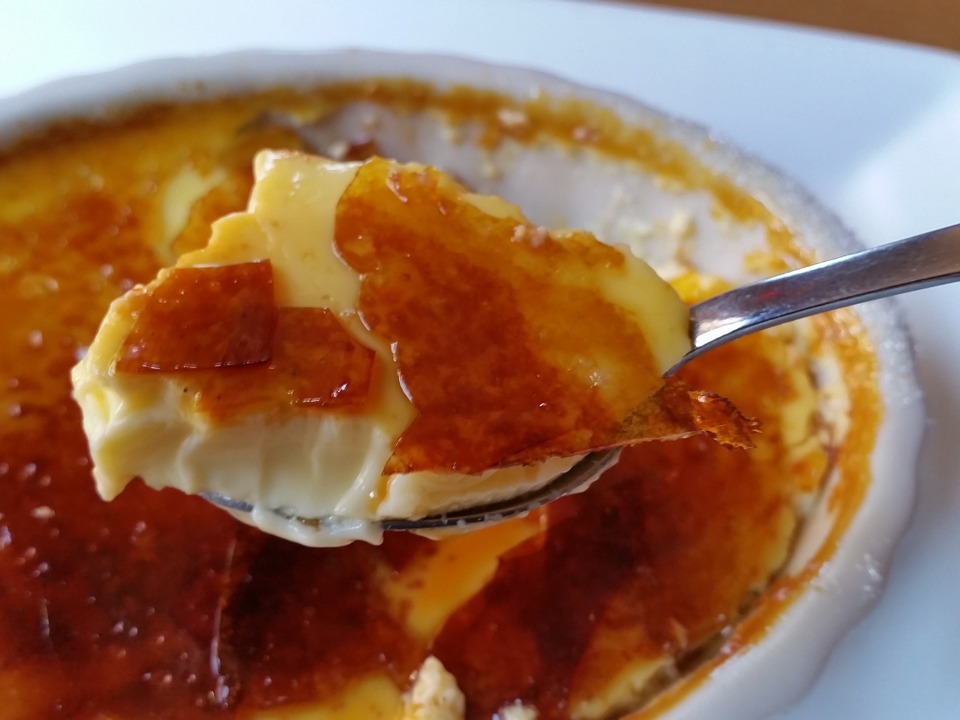Grab Your Kitchen Torch & Let’s Celebrate National Crème Brûlée Day! Posted by Josh Dougherty on Jul 27, 2017 in Culture, Vocabulary
July has a lot of important holidays – we have Canada’s Canada Day on the 1st, the USA’s Independence Day on the 4th, and Bastille Day in France on the 14th. These holidays are all meaningful for a number of reasons, but it would be an absolute tragedy if I didn’t mention July’s most sinfully delicious and sugar-filled holiday: step aside, goofy 4th of July dessert you found on Pinterest, the end of this month is devoted to France’s (arguably) most well-known dessert: la crème brûlée!

With the initial breaking of the crust, your spoon slides down into the creamy, vanilla-infused goodness that promises to take vos papilles (your taste buds) on an adventure. Cold custard with caramelized sugar on top? Sign me up and give me 2 servings! [I have to admit, this is only the second paragraph, and I’m kicking myself for daring to write about crème brûlée (literally, burnt cream) without having one on the table in front of me.]
While this addicting dessert has been around since at least the 17th century, it all but disappeared from popularity in French cuisine until it made a glamorous comeback in the 1980s. It’s not as if it’s a difficult dish to prepare, and its taste certainly doesn’t warrant a disappearance. It wasn’t deleted and replaced with pain au chocolat, so what gives?
Its history involves a bit of origin claims from the English, French, and Catalonians. While each culture claims it as its own, with Trinity College of Cambridge University often cited as the first, the French can rightfully shout “first!” if we look at the recipe’s publication date as proof. First published in a 1691 cookbook entitled Cuisiner royal et bourgeois, the original recipe calls for milk instead of cream and is baked in an oven without a hot bath. The book was later published in English as The Court and Country Cook, and both the original French and English translations are the earliest known mentions of the recipe. So, take that, Cambridge.
With the weekend coming up, it only seems appropriate to celebrate this momentous holiday with a baking party of your own. Below, we’ve written the recipe in paragraph form (with translations provided in the toggle boxes). Pull out your pencils and kitchen torches, and let’s get started!
Les ingrédients :
560 ml de crème 35 %
1 gousse de vanille
ou 5 ml d’essence de vanille
5 jaunes d’œufs
120 ml de sucre
Click for English
2 cups of heavy whipping cream
1 vanilla bean
or 1 teaspoon of vanilla extract
5 egg yolks
1/2 cup of sugar
Tout d’abord, faites préchauffer le four à 170ºC (325ºF). Ensuite faites chauffer la crème durant 5 minutes dans une casserole y ajouter les graines de vanille que vous obtiendrez après avoir coupé la gousse en 2 et gratter les grains. Attention ne faites pas bouillir la crème, laissez juste infuser la vanille ! Si vous n’avez pas de gousse de vanille, vous pouvez la substituer avec de l’ essence de vanille.
Click for English
Battez les jaunes d’œufs avec 60lm de sucre, y ajouter progressivement la crème chaude en remuant afin de ne pas cuire les jaunes. Une fois la préparation homogène, versez-la de manière équitable dans 4 ramequins d’une contenance de 180 ml (3/4 tasse).
Click for English
Cuisez ensuite les crèmes au bain-marie*. Pour réaliser une cuisson au bain-marie, déposez les plats à crème brûlée dans un plat à gratin. Verser de l’eau chaude jusqu’au 3/4 de la hauteur des plats ou des ramequins et faites cuire ensuite au four durant 40 minutes.
Click for English
Finalement sortez les crèmes du four et les laisser tiédir pendant au moins 30 minutes. Les réfrigérer ensuite pendant 2 heures afin qu’elles puissent refroidir complètement. Une fois refroidies, y saupoudrez le sucre supplémentaire et caraméliser rapidement à l’aide d’un fer à crème brûlée ou d’une torche. Vous pouvez aussi les caraméliser dans le four sous la fonction grill de votre four. Les crèmes peuvent être servies immédiatement ou replacées dans le frigo pour une dégustation ultérieure. Bon appetit !
Click for English
*Qu’est-ce que c’est qu’un bain-marie ? (What is a hot water bath?) A hot water bath is essentially 2 pots used to cook 1 dish: the larger pot has water in it, and the second pot holds the food. You place the second pot in the first and put it over heat. The water from pot 1 heats the food in pot 2.

Build vocabulary, practice pronunciation, and more with Transparent Language Online. Available anytime, anywhere, on any device.



